NCERT Solutions Class 7 Science
The NCERT Solutions in English Language for Class 7 Science Chapter – 13 (Motion and Time) has been provided here to help the students in solving the questions from this exercise.
Chapter – 13 (Motion and Time)
1. Classify the following as motion along a straight line, circular or oscillatory motion:
(i) Motion of your hands while running.
(ii) Motion of a horse pulling a cart on a straight road.
(iii) Motion of a child in a merry-go-round.
(iv) Motion of a child on a see-saw.
(v) Motion of the hammer of an electric bell.
(vi) Motion of a train on a straight bridge.
Answer –
(i) Motion of your hands while running. – oscillatory
(ii) Motion of a horse pulling a cart on a straight road. – Motion along a straight line
(iii) Motion of a child in a merry-go-round. – Circular motion
(iv) Motion of a child on a see-saw. – Oscillatory motion
(v) Motion of the hammer of an electric bell. – Oscillatory motion
(vi) Motion of a train on a straight bridge. – Motion along a straight line.
2. Which of the following are not correct?
(i) The basic unit of time is second.
(ii) Every object moves with a constant speed.
(iii) Distances between two cities are measured in kilometres.
(iv) The time period of a given pendulum is constant.
(v) The speed of a train is expressed in m/h.
Answer – Incorrect statements are:
(ii) Every object moves with a constant speed.
(iv) The time period of a given pendulum is constant.
(v) The speed of a train is expressed in m/h.
3. A simple pendulum takes 32 s to complete 20 oscillations. What is the time period of the pendulum?
Answer –
Number of oscillations = 20
Total time taken to complete 20 oscillations = 32 s
Time Period = Total time taken / Number of oscillations
= = 1.6 s
4. The distance between two stations is 240 km. A train takes 4 hours to cover this distance. Calculate the speed of the train.
Answer –
Distance between two stations = 240 kms
Total time take = 4 hrs/240 minutes
Speed = Distance / Time
= = 60 km/h
5. The odometer of a car reads 57321.0 km when the clock shows the time 08:30 AM. What is the distance moved by the car, if at 08:50 AM, the odometer reading has changed to 57336.0 km? Calculate the speed of the car in km/min during this time. Express the speed in km/h also.
Answer –
Initial reading of the odometer = 57321.0
Final reading of the odometer = 57336.0
Distance covered by the car = Final reading of the odometer – Initial reading of the odometer
= 57336.0 – 57321.0 = 15 kms
Starting time of car is 8:30 and it stops at 8: 50
Hence, time taken by car = 20 mins
Speed = Distance / Time
=
20 min = =
hr
Speed in km/hr = = 15 x 3 km/hr
= 45 km/hr.
6. Salma takes 15 minutes from her house to reach her school on a bicycle. If the bicycle has a speed of 2 m/s, calculate the distance between her house and the school.
Answer – Time taken by Salma to reach her school by bicycle = 15 mins= 15 x 60 = 900 s
Speed of Salma’s bicycle= 2m/s
Speed = Distance Covered / Time Taken
Distance covered = speed x time taken
= 2 x 900 = 1800 m
1000m = 1 km
1800 m = = 1.8 kms
7. Show the shape of the distance-time graph for the motion in the following cases:
(i) A car moving with a constant speed.
(ii) A car parked on a side road.
Answer –
(i) A car moving with a constant speed.
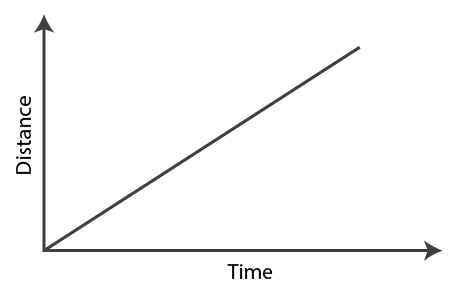
(ii) A car parked on a side road.
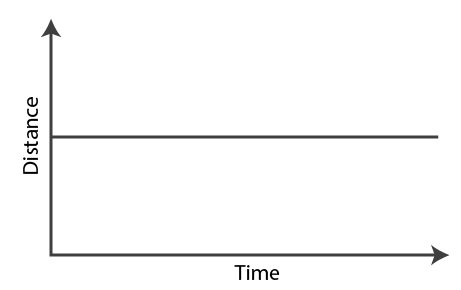
8. Which of the following relations is correct?
(i) Speed = Distance × Time
(ii) Speed = Distance/Time
(iii) Speed = Time/Distance
(iv) Speed = 1/Distance x Time
Answer – (ii) Speed = Distance/Time
9. The basic unit of speed is:
(i) km/min
(ii) m/min
(iii) km/h
(iv) m/s
Answer – (iv) m/s
10. A car moves with a speed of 40 km/h for 15 minutes and then with a speed of 60 km/h for the next 15 minutes. The total distance covered by the car is:
(i) 100 km
(ii) 25 km
(iii) 15 km
(iv) 10 km
Answer – (ii) 25 km
Time taken = 15 min = 15/60 = 0.25 h
Distance covered d1 = speed x time taken = 40 x 0.25 = 10 kms
When the speed of the Car is 60 km/ h
Distance covered d2 = speed x time taken = 60 x 0.25= 15 kms
Total distance covered by the car = d1 + d2
= 10 + 15
= 25 kms
11. Suppose the two photographs, shown in Fig. 13.1 and Fig. 13.2, had been taken at an interval of 10 seconds. If a distance of 100 metres is shown by 1 cm in these photographs, calculate the speed of the fastest car.
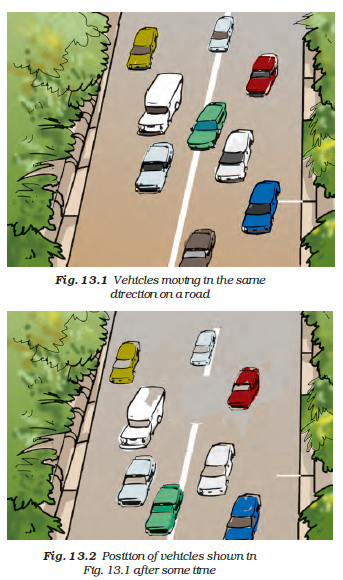
Answer – The distance covered by the blue car (as evident from the photograph) from one white strip to another, which is measured by scale is 1.4 cm.
It is given that 1 cm is equivalent to 100 m.
Therefore, 1.4 cm is equivalent to 140 m.
Distance travelled by the car = 140 m
Time interval between the two photographs = 10 s
Speed = Distance / Time
12. Fig. 13.15 shows the distance-time graph for the motion of two vehicles A and B. Which one of them is moving faster?

Answer – Vehicle A is moving faster than vehicle B.
13. Which of the following distance-time graphs shows a truck moving with speed which is not constant?
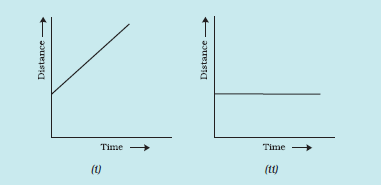
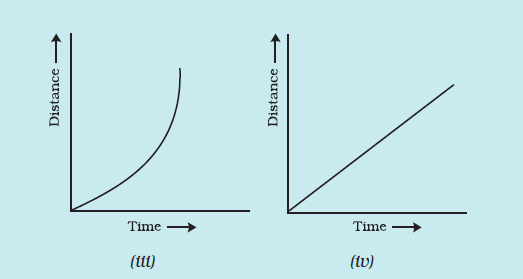
Answer – (iii)

